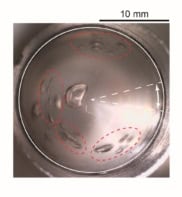
The gradual sliding of tectonic plates across the Earth’s surface may be lubricated by a layer of partial melting, according to researchers from the US. Their study involved conducting magnetotelluric imaging across the Middle America Trench, off the shore of Nicaragua – where the Cocos plate is subducting under the Caribbean plate – and it revealed a far-reaching, high-conductivity layer at a 45–70 km depth in the upper mantle.
“Scientists have known for some time that Earth’s tectonic plates are able to slide across the mantle because they are underlain by relatively low viscosity material in the asthenosphere, but the processes that decrease this viscosity are debated,” explains lead author Samer Naif, a PhD student at the Scripps Institution of Oceanography in San Diego. “Our observations show that the asthenosphere beneath the Cocos plate contains a partially molten channel. Since small amounts of melt in the asthenosphere will significantly lower its viscosity, we infer that this layer could be facilitating the motion of the Cocos plate over the mantle, much like a lubricant.”
Melt layer
The structures and forces that enable tectonic plates to move across the mantle have long been debated. Previous studies have suggested that the low viscosities found in the asthenosphere – the ductile part of the Earth just below the lithosphere, within the upper mantle – that are needed for such movement might be caused by the presence of small quantities of dissolved water. The partially molten channel the team has discovered, however, supports an alternative solution – acting to decouple the motion of the tectonic plate above from the convecting mantle below.
“Our data tell us that water can’t accommodate the features we are seeing,” Naif told physicsworld.com. “The information from the new images confirms the idea that there needs to be some amount of melt in the upper mantle – and that’s really what is creating this ductile behaviour for plates to slide.”
Natural low-frequency electromagnetic-field variations at the Earth’s surface induce secondary electromagnetic fields in the conducting Earth. Taken on the sea floor, magnetotelluric imaging uses measurements of the strengths of these induced fields, as a function of frequency, to generate images of electrical conductivity within the crust and mantle. Naif explains that this technique of exploring the inaccessible mantle is particularly sensitive to the presence of conductive materials – such as the ionic fluids in molten rock. The newly found layer – which extended beyond the sampling region in the direction of the Cocos plate interior – stopped short of the subduction zone. The team believes that here the melt’s buoyancy may keep it from sinking with the descending plate edge – instead pooling under the plate.
Unplanned discoveries
The melt also has a notable characteristic – being 1.5 to 2 times more conductive in the direction of plate motion, compared with parallel to the trench axis. “Shearing of this melt-rich layer at the base of the plate could explain both the anisotropy of conductivity and why oceanic plates seem to move over the underlying mantle with little resistance,” comments Donald Forsyth, a marine geophysicist at Brown University in the US, who was not a part of the team. “A sheared melt layer could lower the viscosity of the mantle in the direction of plate motion, so that there would be little drag at the base of the plate.”
The team had not set out to uncover this feature of the upper mantle. Indeed, the researchers originally intended to study the fluid cycle around the Middle America Trench, then extended their planned array of sea-floor magnetotelluric stations towards the Cocos plate interior with the idea of defining a baseline crust/mantle structure for comparison with the fluid structures at the trench. In total, 50 measuring stations were placed along a 280 km profile of the sea floor. “We went out looking to get an idea of how fluids are interacting with plate subduction [and] we discovered a melt layer we weren’t expecting to find at all – it was pretty surprising,” says another team member, Kerry Key, also from the Scripps Institution of Oceanography.
How and why
Two possibilities are being proposed to explain the origin of this layer of partial melt. In one scenario, the melt occurs and is retained beneath the crust as a result of the mantle upwelling and decompression melting that forms the newly emerging plate material. Another theory proposes that the melt is generated in small amounts throughout the upper mantle and – as a result of buoyancy – rises up to the asthenosphere to pool out in such a layer underneath the cold lithospheric plate above.
“This study shows rather convincingly a strong electrical resistivity contrast between [the] lithosphere above and partial melt beneath,” comments Gregory Houseman from the University of Leeds in the UK, who was not involved in the work. “The authors’ explanation of the low resistivity band makes sense for oceanic lithosphere that is only about 20 million years old – although it implies either a hotter mantle or more water present than is usually quoted in order to get melting at 45 km.” He adds that it would be important to get seismic data for the boundary and check for consistency with the electrical measurements.
In search of more information on the formation of the melt layer, the researchers are now expanding their area of investigation. “We would like to extend the survey to younger regions of the Cocos plate in order to determine if the melt layer exists there as well,” says Naif. “This may help us to determine its origin and also to understand how prevalent this layer is beneath the plate.”
The work is published in Nature.



